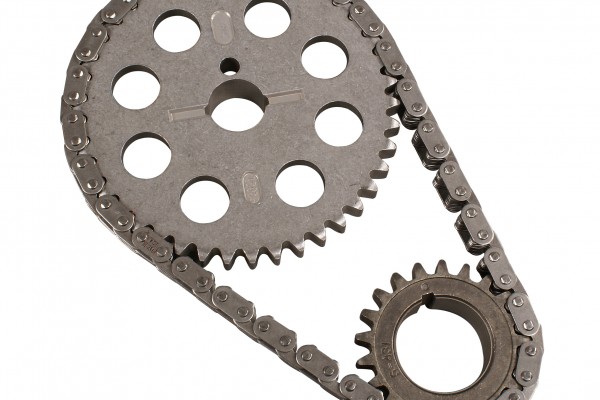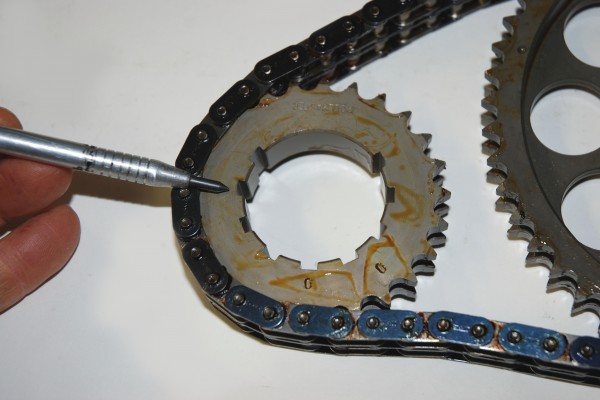A timing chain doesn’t seem like it has a lot to do. All it does is turn the camshaft in concert with the crankshaft, right? Well, yes… and no. On many V8 engines, accessories like the oil pump, mechanical fuel pump, and the distributor are indirectly driven off the camshaft. That means a sloppy timing chain can have a dramatic effect on other parts of the engine.
A timing chain also acts as a vibration damper. It absorbs a certain amount of crankshaft vibration and shock before it is transmitted to the camshaft. This vibration can shorten the life of an OE-style timing chain. High valve spring pressure can also increase harmonic vibration through the camshaft, further stressing the timing chain.
In the not-so-distant past, most OEM-style timing chains didn’t last long. They would wobble and stretch rapidly; many even came with out-of-round sprockets that would throw off cam timing and wear quickly. You had to check the sprockets carefully before installation, then inspect the chain religiously. The only way to advance or retard cam timing was with offset drive pin bushings (and enlarged cam mount bolt holes to allow for movement) or with offset crankshaft keys. Adding insult to injury, the OE-style lower crank gears were of the press-molded or sintered iron variety. Needless to say, reliability at high rpm wasn’t a design priority with these setups.
That changed when aftermarket large-pin timing chains were introduced. These chains have larger-than-stock pins, which actually roll as the chain and sprocket teeth contact. Most have heat-treated gear teeth, and some have keyways in the crank gear that let you advance or retard the camshaft (usually by four degrees). This type of chain is stronger and lighter than the roller-style chains. That reduces operating tension and wear, so this type of chain lasts longer.
Roller Timing Chains
Roller timing chains have been available since the 1960s. The chains have a semi-floating tube that covers the chain links, allowing the chain to literally roll over the gear teeth. This helps reduce friction and chain stretch.
There are two types of roller timing chains available. The single roller chain is much like the chain on a bicycle—the links or side plates of the chain pass over and around a single set of teeth in each gear. A double roller chain is exactly what the name implies—gears with dual sets of teeth with a chain link for each set. Many late model OE engines, like GM’s LS-series V8s, have a single roller timing chain. A single roller is also ideal for most high performance street engines. When you get way up in the horsepower and rpm strata where big lift cams and very high valve spring pressures come into play, a double roller chain can better control harmonic vibration at the cost of a little additional weight. That means more stable cam timing in the engine where even a little deviation can cost horsepower.
A variant of the roller chain is the “true roller.” This chain has pins or rollers that actually spin as they ride over the gear teeth. This further reduces friction compared to standard roller chains with rollers or pins that are fixed in place. You can get a true roller chain in single or double roller versions.
Some roller timing chain sets are manufactured with larger than stock pins. These are typically found in standard roller chains. This design yields a stronger, more durable chain, but adds more friction than a true roller.
Roller timing sets with iron cam gears have wear issues on iron engine blocks. Most engine builders machine the backside of the cam gear or the block area surrounding the cam nose to accept a bushing or a Torrington bearing. This prevents galling between the cam gear and the block. Many roller chain sets have steel gears to eliminate the problem altogether.
Another issue with a roller chain setup is the “chordal action,” a whipping motion that happens when the chain turns on the gear teeth. That whipping motion can literally turn the chain into an “S” shape. Chordal action can weaken the chain and also negatively affect valve timing, ignition timing, and mechanical oil and fuel pumps. That’s why it’s important to check the timing chain on regularly. If it’s tired, replace it.
That’s the short course on timing chains. If you’re planning to build a new engine, rebuild an old one, or simply replace a worn-out timing set, you now have a better idea of what chain will provide the performance you require.







I have a 89 ford e-350 with a 460 fuel injected engine. It has 33k on it but minimal wear. I replaced the cam with comp cans rv strong torque type cam. After installing a sealed power timing chain from you guys it seemed to have to much play at least a 1/2 inch plus which I have never came across before. The engine is oem and has never been out of vehicle. I returned the timing set and sourced another set as that’s the only one you offer for my engine that I could see. The second one is a cloyes heavy duty one and it’s even worse.
So do you recommend getting a shorter chain and what formula could I use to choose the right one. Any help much appreciated. Thanks john
see if the aftermarket offers a timing set for engines that have been line bored they are available in .005 and .010 shorter distance between cam and crank
I’ve got a 99 Dodge Ram Wagon Short Wheel Base Van. Original 5.2L 318 V8 with 130K miles on it. I’m running a Flowmaster 80 series with 2.5″ pipe from the cat back. It’s dropped 2 inches with QA1 Single adjust shocks all around and a fat Hellwig Rear sway bar. Basically I get on it and throw this thing around on the regular and have a hell of a lot of fun doing it! But since it’s a California car I can’t do much to the motor so am I wasting money on a roller chain? Will it make that much of a difference since I’m not swapping cams, intake etc.?
Now tell me about the gear drive timing setup. Does it make so much noise that people won’t use them (I have seen units say lower noise) or are there other problems with them. I have been so close a few times to use the gear set but chicken out.
Hey Chuck, noise quality is a tough question to answer with a firm yes or no. It can be really subjective. We can tell you that we’ve seen folks run timing gears on street cars before. You may want to hit up some cruise-ins/car shows to hear what they sound like in person (or watch some videos on YouTube).
And you’re right–there are more factors to consider beyond the gear noise. Watch the video I linked to in my reply to Vincent’s comment below, and check out this article from Car Craft. They weigh some pros and cons of each setup, to help you come to a decision.
What about timing gears vs timing chains?
Hey Vincent, Summit Racing made This Video to compare/contrast some pros and cons of each setup, does that help answer your question?
Who can recommend me a kit with OEM style but good quality chain for LS motor?
Here are some of the chains Summit Racing carries: https://www.summitracing.com/search/part-type/timing-chains/make/chevrolet/engine-family/chevy-small-block-gen-iii-iv-ls-based-engines
If I read the article correctly you state the aftermarket large pin non-roller chains are lighter and stronger than rollers so they last longer. Then you say the roller chains are less prone to stretch. So they also last longer?
If the primary failure mode of a timing chain is stretch, then the chain that “lasts longer” is the chain that takes longer to stretch.
Can you clarify which chain lasts longer before it stretches: large-pin non-roller, or roller?
Thanks,
Byron
I’ve noticed over the years that the sprockets used with roller chain don’t tend to wear as much as sprockets used with silent chain. One of them wears the sprocket more, the other stretches the chain more. Technically they are sprockets, not gears. (Gears don’t use chain, gears mesh their teeth together.) Although everybody calls them a chain and gear set. O well…..
I am having my Chevy 327 balanced and bored. With all the new engine parts the shop is recommending a double gear timing gear, which I like along with a roller ball bearing attach to the gear. I am not sure of that. I know less vibration inside the engine is good but I am afraid the small bearing would come apart after period of time. Your thoughts? Thank you for your help.
What a load of garbage. A stock Morse chain will outlast a roller chain any day. Stock oem Morse chains have way more plates (that have to wear) before the chain will stretch. Have a look at what timing chains Big Daddy’s Fuel Dragsters ran in the 60’s, yep a stock Morse chain and 1500hp on Nitro. Fact.
I need to shorten a duplex (valve) timing chain by one link for s Datsun 1600. Can I use a standard master link ?